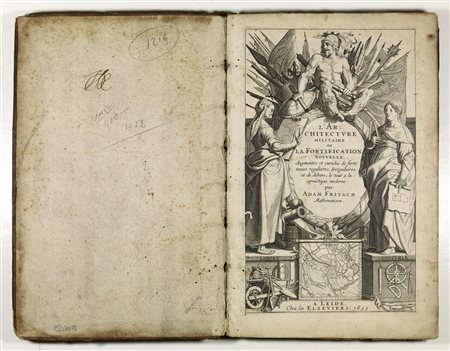 Itineris Casa d'Aste - Via Tiziano Vecellio 34/D, 10126 Torino
Itineris Casa d'Aste - Via Tiziano Vecellio 34/D, 10126 Torino
DIPINTI E SCULTURE ANTICHI E DEL XIX SECOLO - LIBRI ANTICHI - STAMPE E DISEGNI Prima Sessione - Libri antichi, disegni e stampe
giovedì 18 giugno 2020 ore 15:00 (UTC +01:00)
Adam Fritach (1602 - 1664) L'Architecture Militaire ou La Fortification...
Adam Fritach (1602 - 1664)
L'Architecture Militaire ou La Fortification Nouvelle. Augmentée et enrichie de fortresses regulieres, Irregulieres, et de dehors; le tout a la practique modern. A Leide Chez les Elzeviers 1635
In folio (mm 313x202). Pag. (8), 179, (1). Seconda edizione, prima in francese. Frontespizio calcografico finemente inciso, a piena pagina con disegni allegorici, testatine, capilettera floreali, finalini, 35 bellissime tavole incise a doppia pagina fuori testo illustranti diversi tipi di fortificazioni, 8 tabelle di misure, legatura coeva in piena pelle. Piatti e cerniere usurati, fioriture, bruniture e fori di tarlo. La pagina 179-180 con l'angolo inferiore esterno mancante ma senza perdita di testo. Un classico lavoro militare scritto durante le fasi finali della Guerra dei Trent'anni. "è uno dei tratti piω importanti delle fortificazioni del 17 ° secolo, anche se molto è stato scritto sul vecchio stile di fortificazione olandese. Freitag ha partecipato attivamente agli assedi di Herzogenbosch nel 1629 e Maastricht nel 1632. Nel suo trattato, ha anche ha presentato strumenti, principalmente ponti ed edifici militari all'interno di solide piazze ".
Cfr. Schutte 316; Willems 425; Avery 356; Brunet II 1390; Pollak,24: "This lavishly illustrated treatise is considered one of the most influential published in the XVII century. Freitag's treatise definitively interpreted the Dutch fortification style and made it available to a large German public" - Berlin Katalog, 3525 cita la prima ediz. del 1631.
In folio (313x202 mm). Second edition, first in French. Engraved title, (8), 179, (1) pp. 35 double-page plates, 8 double page tables. 3 parts in one. Contemporary leather, spine and boards rubbed with minor loss. Contemporary binding in full leather. Worn plates and hinges, blooms, burnishes and worm holes. Pages 179-180 with the lower outer corner missing but without loss of text. A classic military work during the final stages of the Thirty Years War. "It is one of the most important tracts of the fortifications of the 17th century, although much was written about the old Netherlandish style of fortification. Freitag actively participated in the sieges of Herzogenbosch in 1629 and Maastricht in 1632. In his treatise, he also presented instruments, but mainly bridges and military buildings within firm squares."
Cf. Schutte 316; Willems 425; Avery 356; Brunet II 1390; Pollak,24: "This lavishly illustrated treatise is considered one of the most influential published in the XVII century. Freitag's treatise definitively interpreted the Dutch fortification style and made it available to a large German public" - Berlin Katalog, 3525 cites the first edition of 1631.





